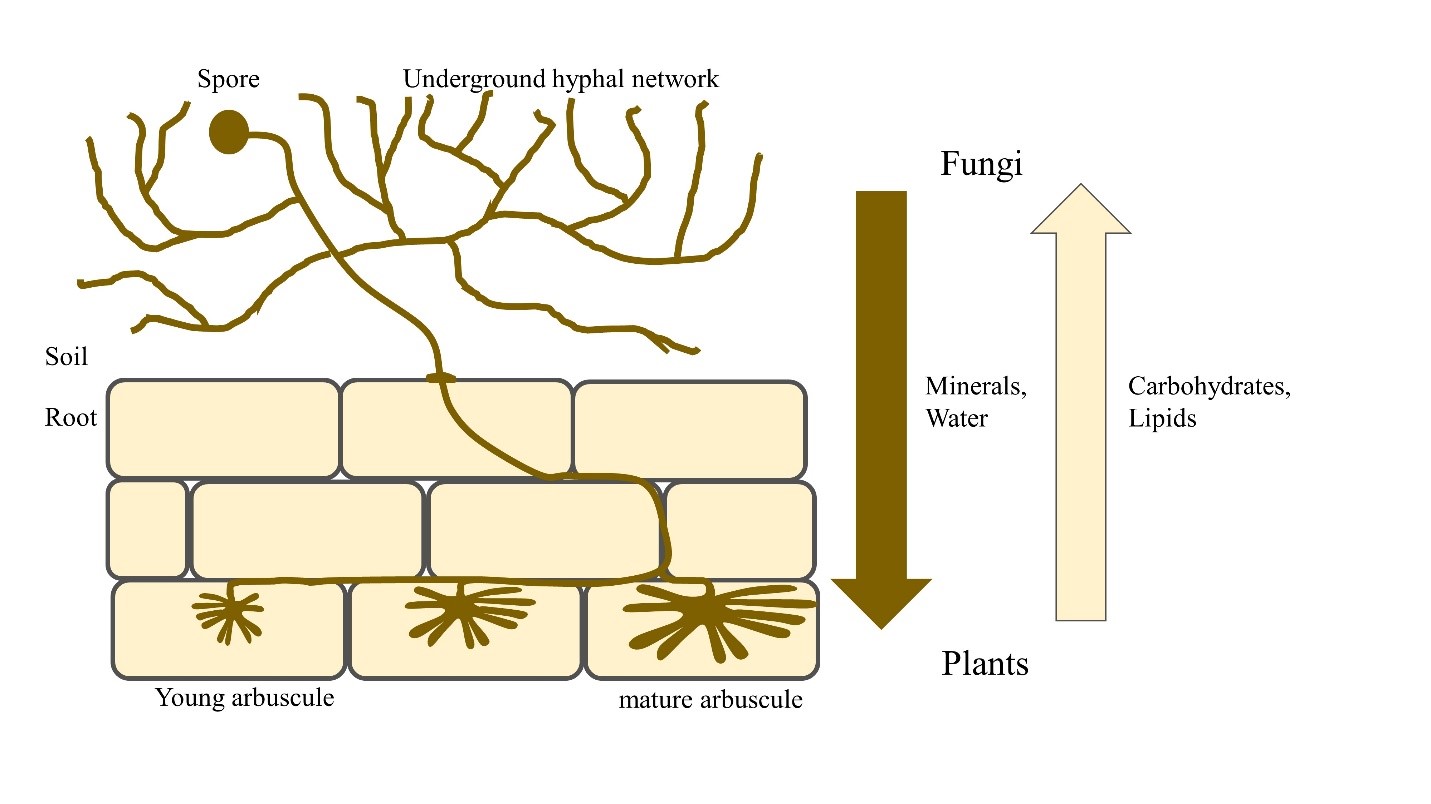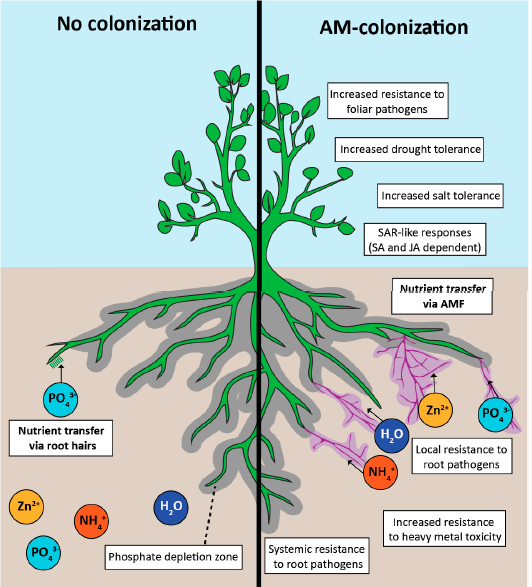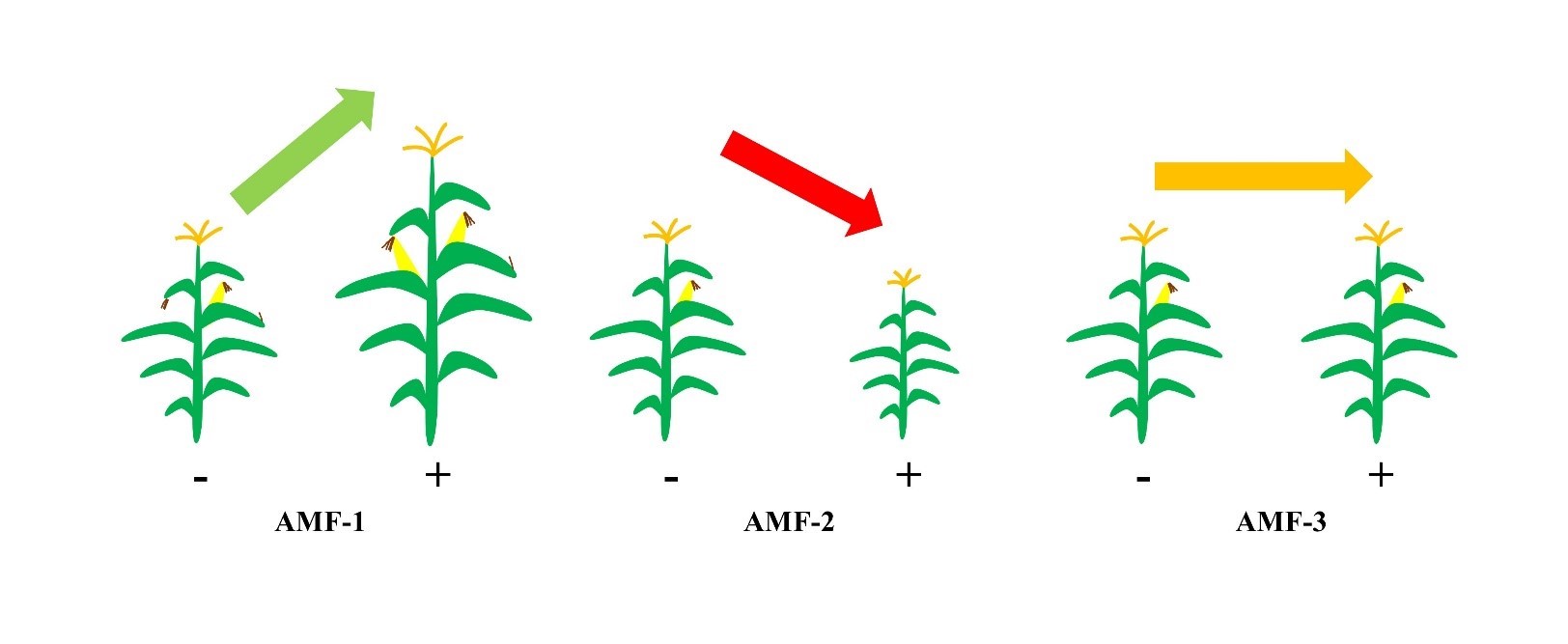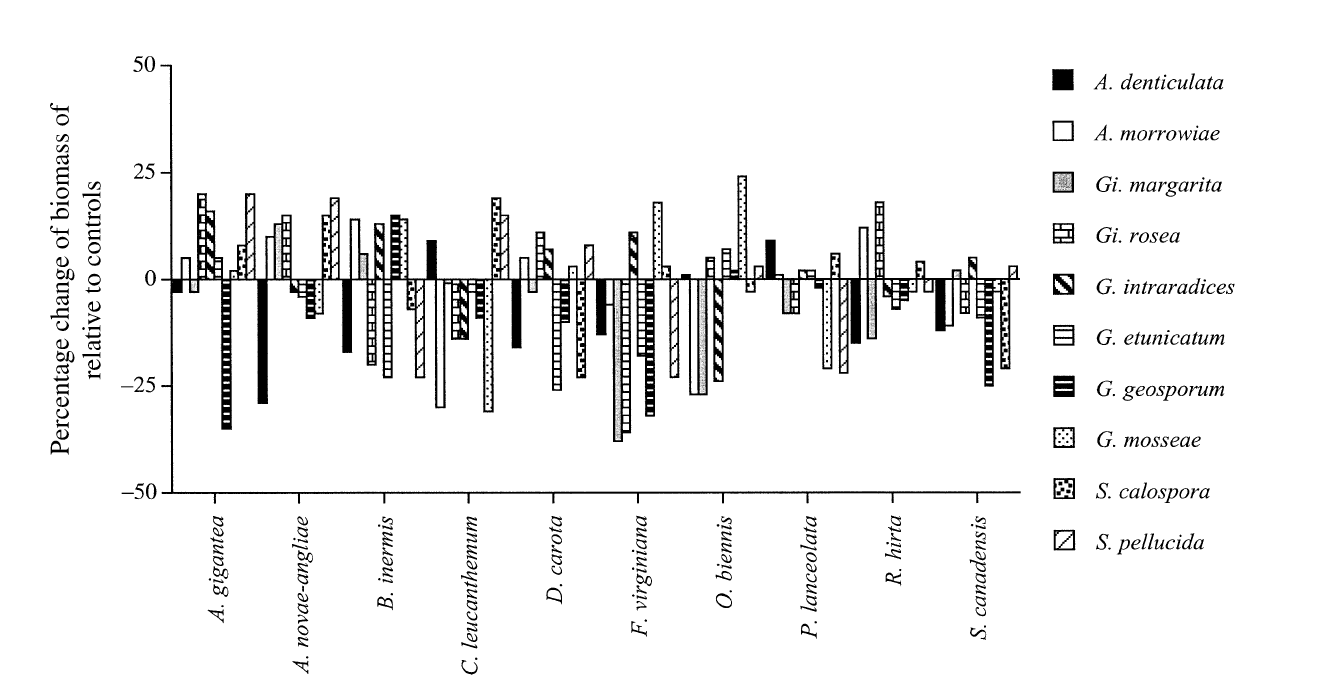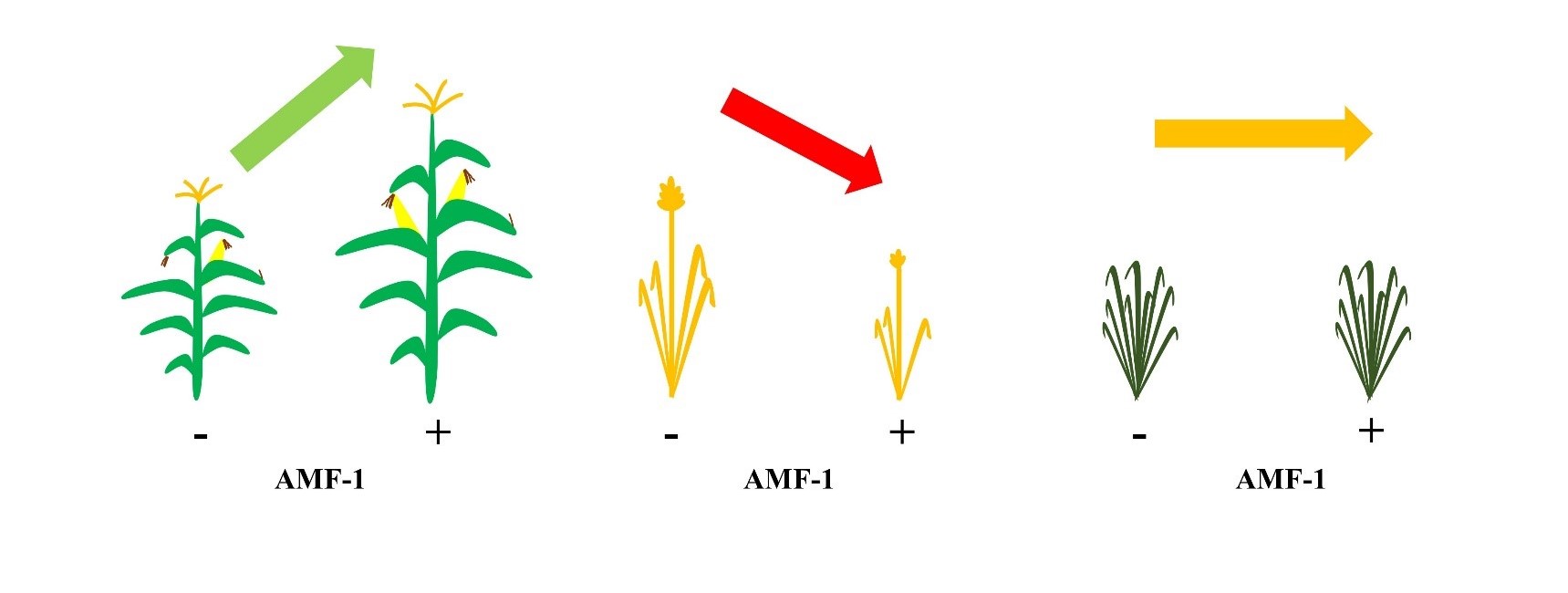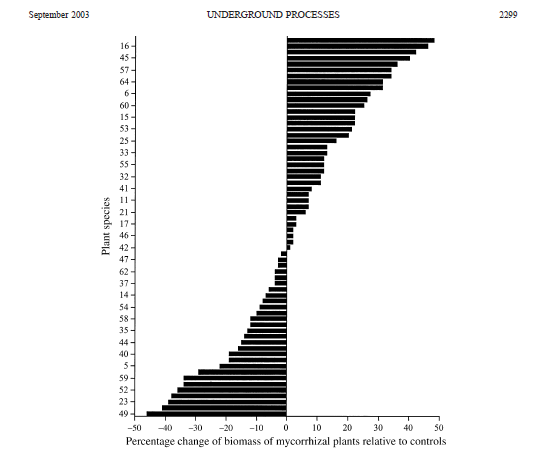By Florence Sessoms
What are they?
Arbuscular mycorrhiza fungi (AMF) are soil microorganisms able to form mutualistic symbiosis with most terrestrial plants. Spores that are present in soil germinate, infect the root system, and form arbuscule structures inside the cells (Figure 1). Arbuscules are the site of nutrients exchange between the plant and the fungi. Another characteristic of this symbiosis is the presence of a large mycorrhizal network around the root system.
The multiple benefits of arbsuscular mycorrhizal symbiosis
Improved nutrient acquisition and greater biomass. Plants cannot move; they are anchored to one spot on the ground, and their nutrition depends on the availability of the mineral resources around their root system. When plants are colonized with arbuscular mycorrhizal fungi, they have access to a larger resource area, thanks to the dense network of extraradical hyphae. Hence, AMF colonized plants often present a greater nutritional status (P, N and other nutrients) resulting in increased plant biomass. Plants exchange nutrients, carbohydrates, and lipids with AMF (Figure 2). AMF are obligate biotrophs, meaning they are dependent on their hosts for nutrients and cannot survive without the presence of a host.
Better drought tolerance. Extraradical (outside of the roots) hyphae are very thin (below 20 µm) and have access to water in soil pores that cannot be reached by fine root hairs. Therefore, AMF-colonized plants often demonstrate greater water uptake (Figure 2). In addition, many research studies on the effect of AMF colonization during drought stress have revealed that colonization led to better plant stomatal regulation and improved root hydraulic properties.
Better resistance against biotic stresses. Plants colonized with AMF present better resistance to several soil pathogens. Previous studies have demonstrated reduced disease incidence of various pathogens such as Fusarium, Rhizoctonia, pathogenic bacteria, Phytophthora, Pythium, and parasitic nematodes. The presence of mycorrhizal fungi in the roots results in the establishment of a mycorrhizal-induced resistance (MIR), a type of priming that could explain why colonized plants are more resistant to this large set of soil pathogens (Figure 2). In addition, AMF-colonized plants display root morphological changes and variation in root exudates that could lead to a decrease in pathogen virulence, or an alteration to the soil microbial community, blocking the development of these soil pathogens. Lastly, the extensive colonization of the roots systems by the mycorrhizal fungi could prevent the infection and establishment of other root pathogens.
However, the effect of AMF colonization on shoot pathogens is less understood. In some cases, AMF seem to decrease disease while for other cases, AMF seem to lead to greater disease severity. Assumptions have been made that effect of AMF on foliar pathogens would depend on the pathogens’ lifestyle.
Decrease in weed incidence. Certain plants species cannot be colonized by AMF; for these non-host species, the presence of AMF in soil can result in reduced germination, decreased growth and development, and smaller roots. Interestingly, many agricultural weeds belong to families that are predominantly non-hosts for AMF (Amaranthaceae, Brassicaceae, Caryophyllaceae, Chenopodiaceae, Cyperaceae, and Polygonaceae). A study performed on pigweed and corn spurry demonstrated that the presence of AMF in soil led to reduced germination and stunted development of these two weeds. Altogether, the assumption can be made that the presence of AMF in natural ecosystems would not favor non-host weeds by reducing their ability to germinate and grow.
Are the benefits always present?
There is no host specificity with mycorrhizal fungi. The symbiosis is very old and predates the divergence of the plant lineage. The presence of arbuscule structures can be found in 400 million-year-old Aglaophyton major fossils. Early plants did not possess a developed root system, and the presence of the AMF hyphal network would have allowed them to obtain the nutrients and water necessary during the colonization of the terrestrial lands.
However, a certain host-specialization is present between the fungal species and the host. A plant host can display improved plant biomass with one AMF species and decreased biomass with one another (Figure 3 and Figure 4).
Similarly, one type of AMF can increase or decrease the biomass of several plant species (Figure 5 and Figure 6).
This host specialization can be observed for the nutrient status and biotic and abiotic stresses. Hence, it is very important to choose the most appropriate AMF species for each plant of interest.
Secondly, phosphate and nitrogen are two regulators of AMF establishment in roots. Increased presence of these two macronutrients leads to reduced root colonization and the loss the AMF benefits. On another hand, when these two nutrients are too low, the nutrient uptake benefits can be shadowed by the carbon and lipid losses to feed the AMF. Therefore, it is very important to maximize the P and N fertility to obtain best benefits from the symbiosis.
In summary, plants benefit from the presence of AMF fungi in soil. However it is also important to use inoculum of fungal species that “matches” the plant host and to apply an appropriate fertility management practice for maximizing the multiple benefits of this interaction. In my next blog, I will discuss how AMF interact with turfgrass species.
Any questions? Contact me at [email protected]
References
Begum et al, (2019). Role of arbuscular mycorrhizal fungi in plant growth regulation: implication in abiotic stress tolerance. Frontiers in Plant Science, doi: 10.3389/fpls.2019.01068
Chitarra et al, (2016). Insight on the impact of arbuscular mycorrhizal symbiosis on tomato tolerance to water stress. Plant Physiology, 171: 1009-1023.
Jacott et al, (2017). Trade-offs in arbuscular mycorrhizal symbiosis: disease resistance, growth response and perspective for crop breeding. Agronomy, 7(75): doi:10.3390/agronomy7040075.
Klironomos (2003). Variation in plant response to native and exotic arbuscular mycorrhizal fungi. Ecology, 84(9): 2292-2301.
Pozo and Azcón-Aguilar (2007). Unraveling mycorrhiza-induced resistance. Current Opinion in Plant Biology, 10: 393–398.
Remy et al, (1994). Four hundred-million-year-old vesicular arbuscular mycorrhizae. PNAS, 91:11841-11843.
Veiga, et al (2011). Can arbuscular mycorrhizal fungi reduce the growth of agricultural weeds? PLoS ONE, 6(12):e27825.
